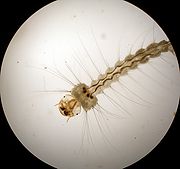
Inquiline
Encyclopedia

Zoology
Zoology |zoölogy]]), is the branch of biology that relates to the animal kingdom, including the structure, embryology, evolution, classification, habits, and distribution of all animals, both living and extinct...
, an inquiline (from Latin
Latin
Latin is an Italic language originally spoken in Latium and Ancient Rome. It, along with most European languages, is a descendant of the ancient Proto-Indo-European language. Although it is considered a dead language, a number of scholars and members of the Christian clergy speak it fluently, and...
inquilinus, "lodger" or "tenant") is an animal
Animal
Animals are a major group of multicellular, eukaryotic organisms of the kingdom Animalia or Metazoa. Their body plan eventually becomes fixed as they develop, although some undergo a process of metamorphosis later on in their life. Most animals are motile, meaning they can move spontaneously and...
that lives commensally
Commensalism
In ecology, commensalism is a class of relationship between two organisms where one organism benefits but the other is neutral...
in the nest, burrow, or dwelling place of an animal of another species. For example, some organisms such as insects may live in the homes of gopher
Gopher (animal)
The term gopher as it is commonly used does not relate to any one species, but is a generic term used to describe any of several small burrowing rodents endemic to North America, including the pocket gopher , also called true gophers, and the ground squirrel , including Richardson's ground squirrel...
s and feed on debris, fungi, roots, etc. The most widely distributed types of inquiline are those found in association with the nests of social insects, especially ant
Ant
Ants are social insects of the family Formicidae and, along with the related wasps and bees, belong to the order Hymenoptera. Ants evolved from wasp-like ancestors in the mid-Cretaceous period between 110 and 130 million years ago and diversified after the rise of flowering plants. More than...
s and termite
Termite
Termites are a group of eusocial insects that, until recently, were classified at the taxonomic rank of order Isoptera , but are now accepted as the epifamily Termitoidae, of the cockroach order Blattodea...
s — a single colony may support dozens of different inquiline species. The distinctions between parasites
Parasitism
Parasitism is a type of symbiotic relationship between organisms of different species where one organism, the parasite, benefits at the expense of the other, the host. Traditionally parasite referred to organisms with lifestages that needed more than one host . These are now called macroparasites...
, social parasites
Parasitism
Parasitism is a type of symbiotic relationship between organisms of different species where one organism, the parasite, benefits at the expense of the other, the host. Traditionally parasite referred to organisms with lifestages that needed more than one host . These are now called macroparasites...
, and inquilines are subtle, and many species may fulfill the criteria for more than one of these, as inquilines do exhibit many of the same characteristics of parasites. However, parasites are specifically not inquilines, because by definition they have a deleterious effect on the host species, while inquilines do not.
Examples of the inquiline relation are known especially among the gallflies (Cynipidae family). In the sub-family Synerginae this mode of life predominates. These insects differ but little in structure from the true gallflies, but they cannot produce galls and consequently deposit their eggs within those of other species. They infest certain species of galls, such as those of the blackberry and some oak galls, in large numbers, and sometimes more than one kind occur in a single gall. Perhaps the most remarkable feature of these inquilines is their frequent close resemblance to the insect that produces the gall they infest.
The term inquiline has also been applied to aquatic invertebrates that spend all or part of their life cycles in phytotelma, water-filled structures produced by plants. For example, Wyeomyia smithii
Wyeomyia smithii
Wyeomyia smithii, the pitcher plant mosquito, is an inquiline invertebrate found only in the phytotelma of the purple pitcher plant, Sarracenia purpurea. In this microcommunity of bacteria, rotifers, protozoa, and midges, W...
, Metriocnemus knabi, and Habrotrocha rosa are three invertebrates that make up part of the microecosystem within the pitchers of Sarracenia purpurea
Sarracenia purpurea
Sarracenia purpurea, commonly known as the purple pitcher plant, northern pitcher plant, or side-saddle flower, is a carnivorous plant in the family Sarraceniaceae...
.

